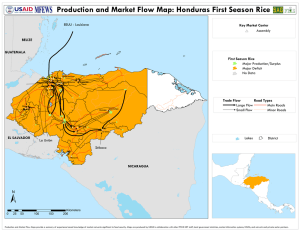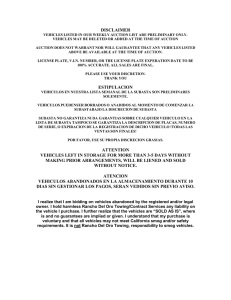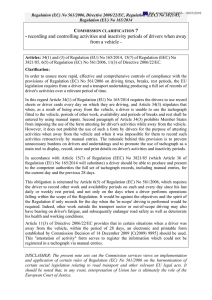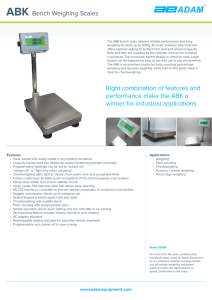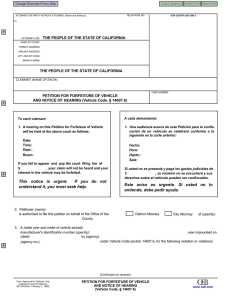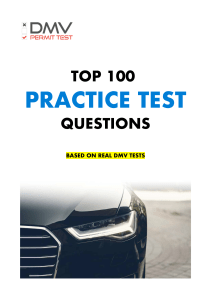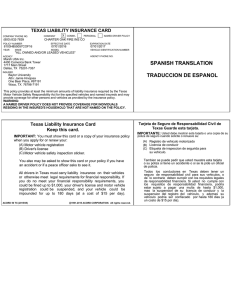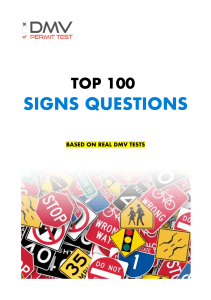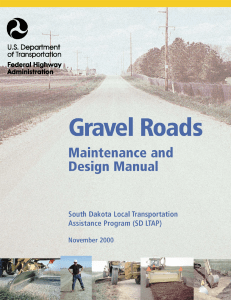rules of the road
Anuncio
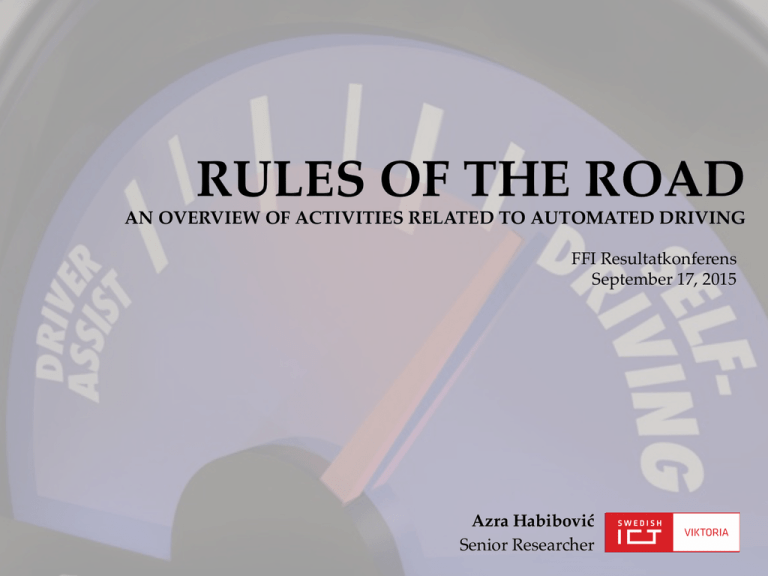
RULES OF THE ROAD ! AN OVERVIEW OF ACTIVITIES RELATED TO AUTOMATED DRIVING FFI Resultatkonferens September 17, 2015 Azra Habibović Senior Researcher Swedish regulations Vienna Convention on Road Traffic => Swedish Road Traffic Ordinance Swedish Government Overall responsibility that the Ordinance is respected Municipalities Special road traffic rules in urban areas www.viktoria.se County Administrative Board Special road traffic rules in rural areas International regulations 1968 Vienna Convention on Road Traffic, Article 8: “Drivers shall at all times be able to control their vehicles or guide their animals. When approaching other road users, they shall take such precautions as may be required for the safety of the la=er.” 2014 UNECE WP.1 on Road Traffic Safety adopted an amendment of Article 8: ”Vehicle systems which influence the way vehicles are driven”…. ….such systems can be overridden or switched off by the driver… ….shall be deemed to be in conformity with paragraph 5 of this Article…” Signatory states have to amend their national laws accordingly. www.viktoria.se AD-regulations in Sweden • Swedish Transport Agency: o There is no hinder for automated vehicles given that there is a driver in the vehicle. • There are limited possibilities to grant exemptions from the Swedish Road Traffic Ordinance. • There are broader exemption possibilities in the vehicle legislation (but exceptions are allowed only under certain conditions). o Swedish Transport Agency can give permission for vehicles to be used in testing. www.viktoria.se AD-regulations in Europe The UK o Government has published a Code of Practice: legal framework for testing on public roads. o Testing activities started. Germany o Federal Highway Research Institute: highly and fully automated vehicles do not comply with German law. o Federal states can grant exemptions from the Road Traffic Licensing Regulations allowing the testing of automated vehicles (provided there is a driver in the driver’s seat who has full legal responsibility for the safe operation of the vehicle). Finland o Ministry of Transport and Communication preparing an amendment to the Road Traffic Act regarding AD-­‐‑testing on pre-­‐‑selected public roads (expected to come into force in 2015 and be valid for 5 years). o Some testing on public roads conducted (CityMobile2). www.viktoria.se France o Announced the adoption of the necessary legal framework to enable AD-­‐‑testing on public roads as of 2015 under strict conditions. Italy o Testing on public roads has been granted exemptions. Greece o A legislative act stating that AD-­‐‑testing on public roads is allowed under specific conditions has been prepared and will be proposed to the Greek Parliament. Belgium o Region of Flanders plans to set up pilots under 2015: Tesla vehicles will drive on the Belgian public motorways this autumn. o Pilots with AD-­‐‑buses running to and from Brussels airport with start 2018 (CityMobile2). The Netherlands o A proposal to extend exemption rules to allow large-­‐‑ scale AD-­‐‑testing is approved. The parliament needs to approve the necessary legislative changes under 2015. o In 2016, the Netherlands will take over the EU-­‐‑ presidency and have stated that they might then insist on amendments to international regulations. Scania tested semi-­‐‑automated trucks on Dutch roads in Feb 2015. www.viktoria.se A pilot study with two WE-pods will start on pre-defined public roads in May 2016. AD-regulations in Russia Regulatory changes are planned for 2017 (around the time that KAMAZs pilot study is expected to start on the roads in Tatarstan). www.viktoria.se AD-regulations in Asia South Korea Japan o Testing on public roads with an AD-license o The government has an agenda for ADplate allowed since Sept 2013 (provided development: under 2015 it will set up there is a driver in the driver’s seat who standards for testing on public roads and has full legal responsibility) secure exclusive radio frequencies for V2X. o Government is currently formulating concrete measures. China Singapore o No specific regulations, but it has been o Land Transport Authority (LTA) is reported that the Research Institute of Highway Ministry of Transport will work developing regulations for implementing jointly with Baidu on this topic. AD in transport network. o Testing on public roads allowed (provided o In August 2014, LTA announced it was there is a driver in the driver’s seat who setting up the Singapore Autonomous has full legal responsibility). Vehicle Initiative (SAVI) with public road testing beginning January 2015. o Some tests on public road are conducted. www.viktoria.se AD-regulations in Australia Australia is not a signatory of the Vienna Convention. South Australia aims to become the first state to adapt its road laws: o Outlined a plan in the state parliament to reform Motor Vehicles Act and Road Traffic Act. o First tests in real-­‐‑world traffic in Nov 2015: Volvo Cars on pre-­‐‑selected roads in Adelaide. Discussions on the federal level: o Federal Chamber of Automotive Industries (FCAI) & Australian government are discussing how to identify and put in place the necessary federal legislation. www.viktoria.se AD-­‐‑regulations in the US The US is not signatory of the Vienna Convention. There is no federal AD-­‐‑regulation. NHTSA plans to test the technology as it emerges and collect data to inform future federal regulation. NHTSA has issued a preliminary statement of policy: advises states against authorizing members of the public to use self-­‐‑driving vehicle technology at this time. www.viktoria.se Source: h_p://cyberlaw.stanford.edu/wiki COMPARING THE STATE LEGISLATION (PART I) AD-­‐‑regulations in the US STATE CA AV’s can be AV’s must have AV’s must have AV’s must have Operator required to be operated by means to internal indicator indicator which seated inside the vehicle persons engage and which indicates alerts operator of prepared to take control of AV at any moment designated by disengage when autonomous tech failure technology is the jeopardizing safety engaged manufacturer of of vehicle operation the autonomous and allows operator technology to resume control ✔ ✔ DC ✔ ✔ ✔ ✔ ✔ FL ✔ ✔ ✔ ✔ MI ✔ ✔ ✔ ✔ NV NY ✔ ✔ ✔ ✔ ✔ ✔ ✔ Source: h_p://www.connectedvehicleworkshop.com/wp-­‐‑content/uploads/2014/12/Raymond-­‐‑Brescia-­‐‑Presentation.pdf. www.viktoria.se COMPARINGTHE THESTATE STATELEGISLATION LEGISLATION(PART (PART2) I) COMPARING AD-­‐‑regulations in the US STATE STATE AV’s can be AV’s must have AV’s must have AV’s must have Operator required to be operated by means to internal indicator indicator which seated inside the vehicle Dep’t indicates of Motor Special Proof oftoinsurance Manufacturers, requires Plate personsExplicitly engage andStatewhich alertsLicense operator of prepared take control of compliance with Vehicles directed to / Separate Permit / required testing distributors, AV atbefore any moment designated by disengage when autonomous tech failure regulations Special License dealers absolved is the all Federal Motor createtechnology jeopardizing safety Vehicle Safety /adopt rules designation required of liability for engaged manufacturer of of vehicle operation implementing allegedthe defects in Standards / autonomous and allows operator converted testing of AV’s on technology Federal to resume control vehicles for Regulations public roads. defects occurring supersede state after delivery of motor vehicle law sections about vehicle AV’s CA CA DC DC FL ✔ MIFL ✔ ✔ NVMI ✔ ✔ NY NV ✔ NY ✔ ✔ ✔ ✔ ✔ ✔ ✔ ✔ ✔ ✔ ✔ ✔ ✔ ✔ ✔ ✔ ✔ ✔✔ ✔✔ ✔✔ ✔ ✔✔ ✔✔ ✔ ✔ ✔ ✔ ✔ ✔ ✔ ✔ Source: h_p://www.connectedvehicleworkshop.com/wp-­‐‑content/uploads/2014/12/Raymond-­‐‑Brescia-­‐‑Presentation.pdf. www.viktoria.se Summary • • • • Some regulatory frameworks are being developed for testing, but not for future use cases. Inconsistent state laws might increase costs and hinder the use of this technology. Uncertainty on market deployment strategies complicates the regulatory work. Regulators and developers should actively plan to minimize legacy risks. www.viktoria.se What decisions do policymakers face? • How, if at all, should the use of AVs be regulated, and at what level? • What kind of vehicles should be allowed on the road, and who is allowed to operate them? • How should the safety of AVs be tested, and by whom? To what safety standards should AVs be held? • How might different liability regimes shape the timely and safe adoption of AVs, and what are the tradeoffs? Under what conditions would limitations on tort liability be appropriate? • What are the implications of a patchwork of state-by-state laws and regulations, and what are the tradeoffs in harmonizing these policies? • To what extent should policymakers encourage the adoption of AVs; e.g., through smart road infrastructure, dedicated highway lanes, manufacturer or consumer incentives? Source: h_p://www.rand.org/ www.viktoria.se Nyfiken på automatiserade fordon? Anmäl dig till Viktorias nyhetsbrev! h=p://nyhetsbrev.viktoria.se www.viktoria.se
